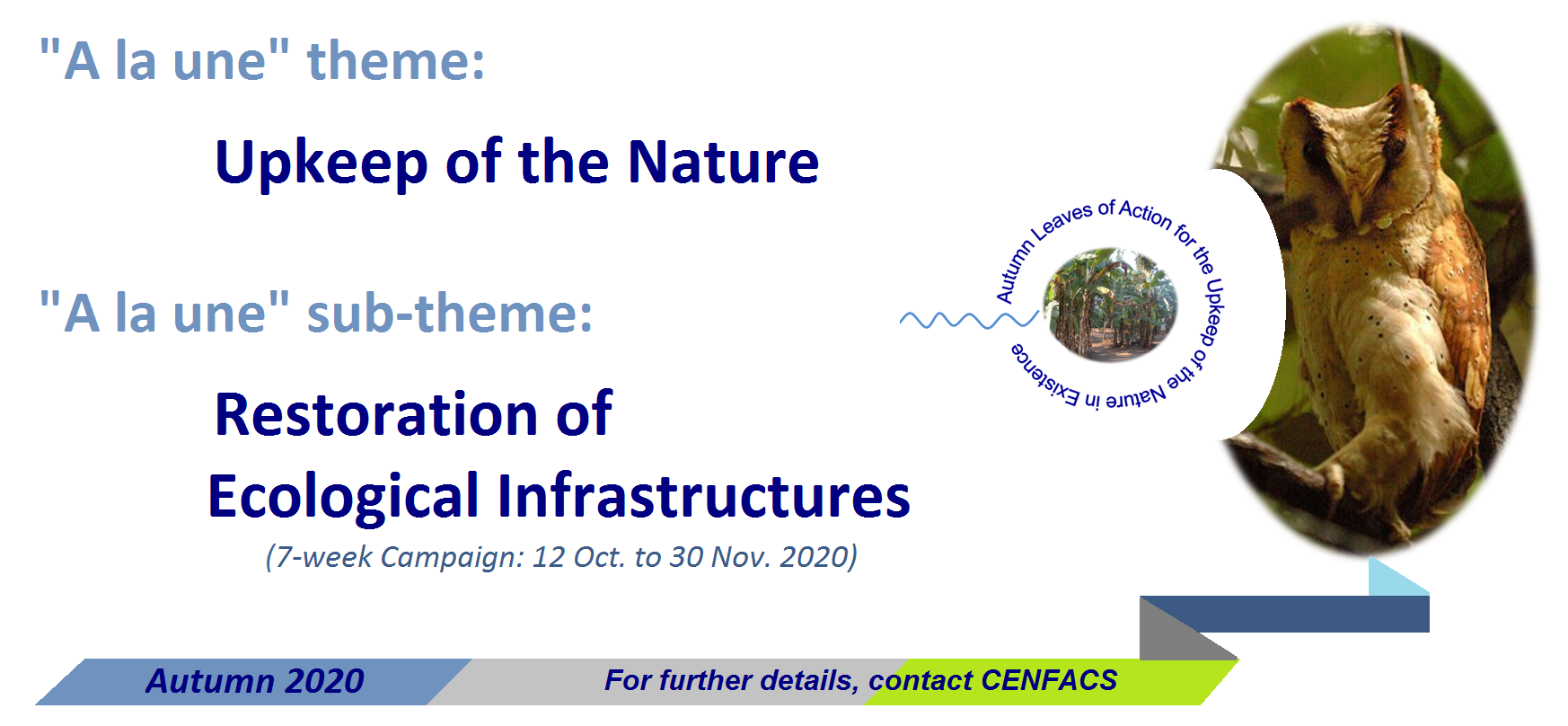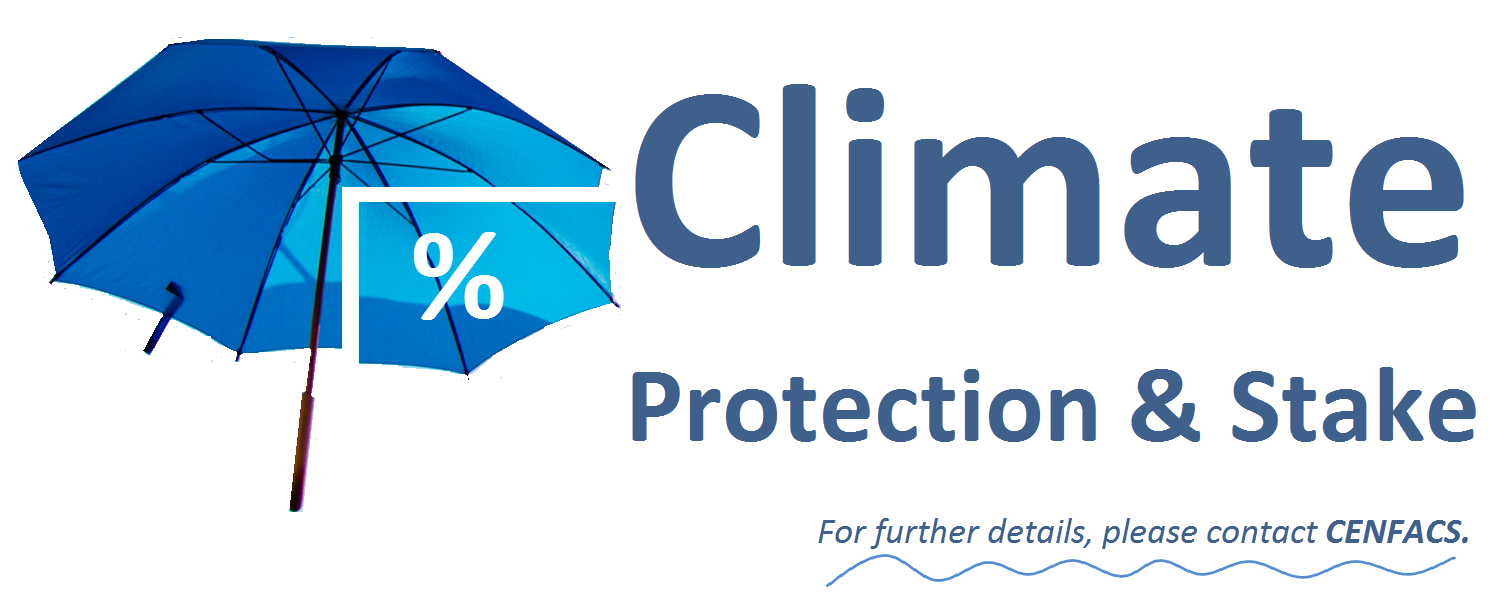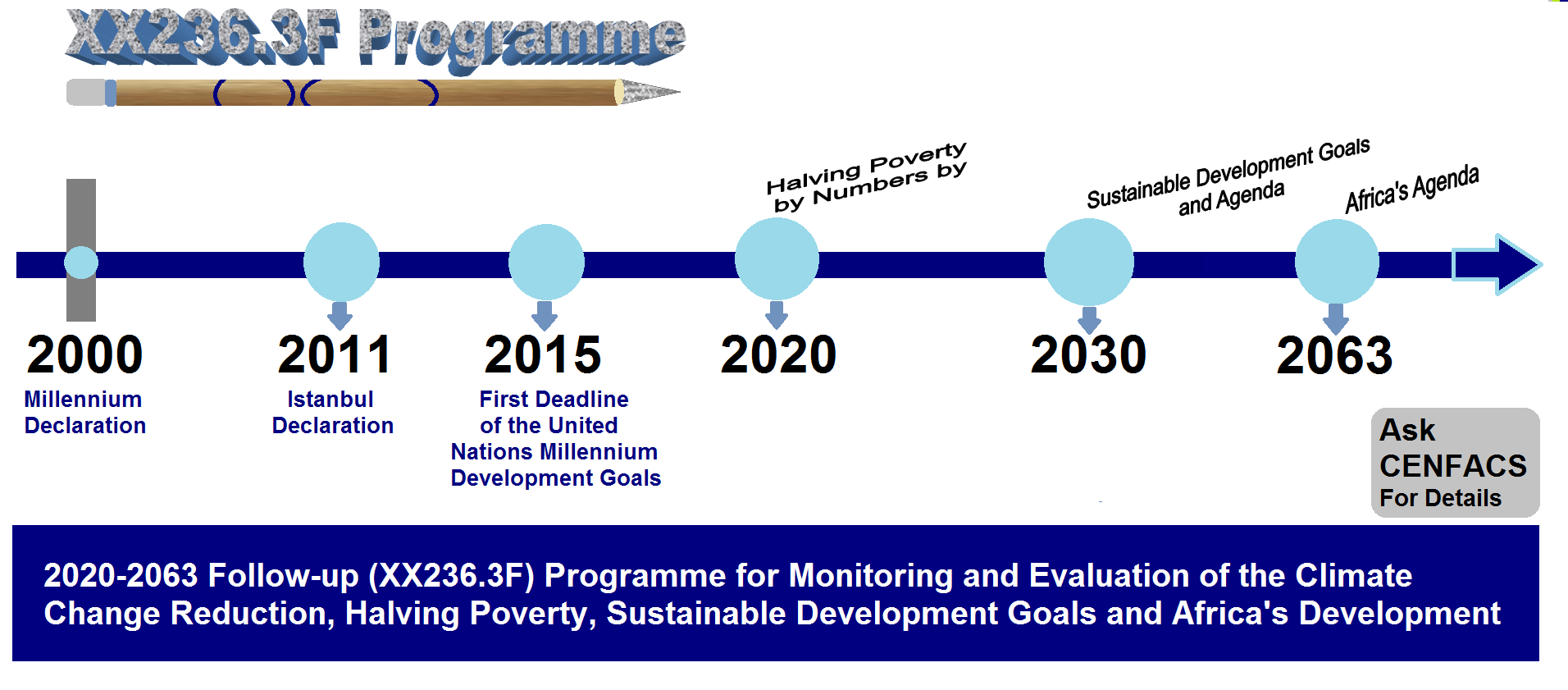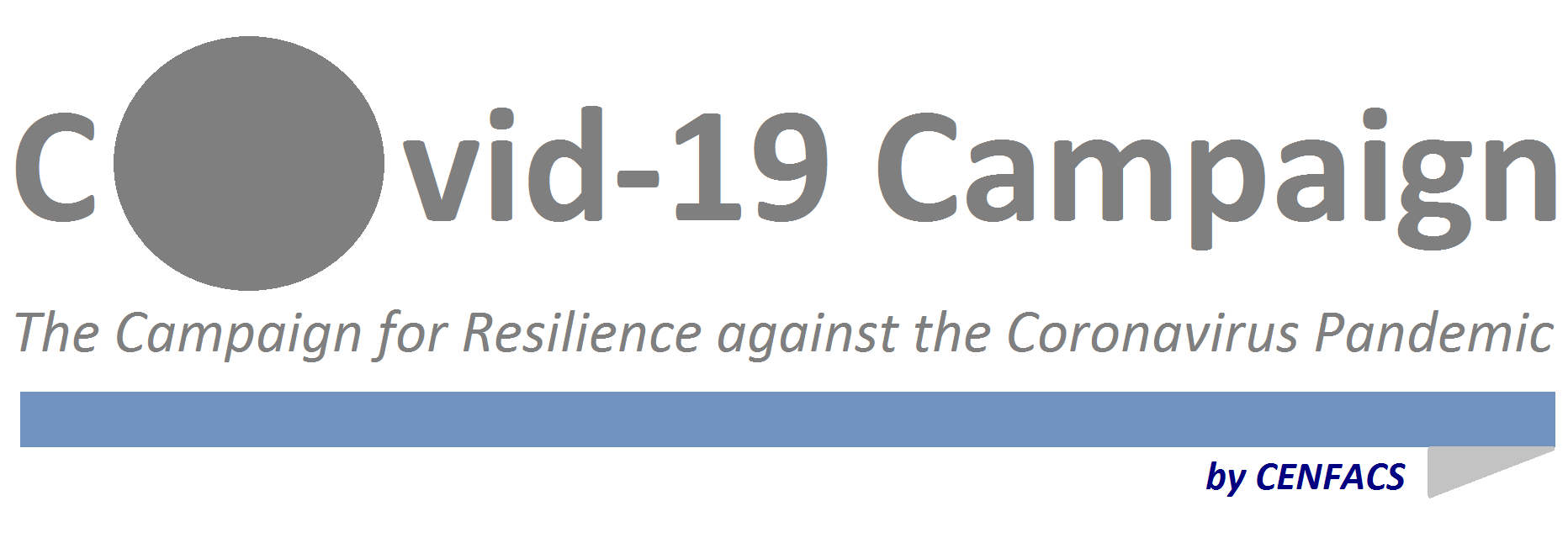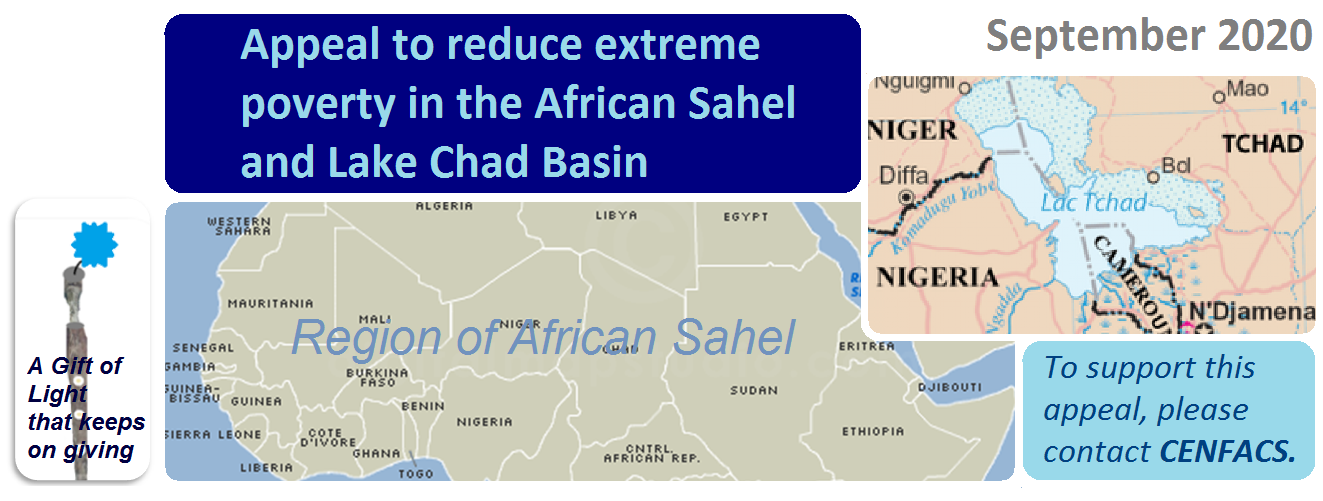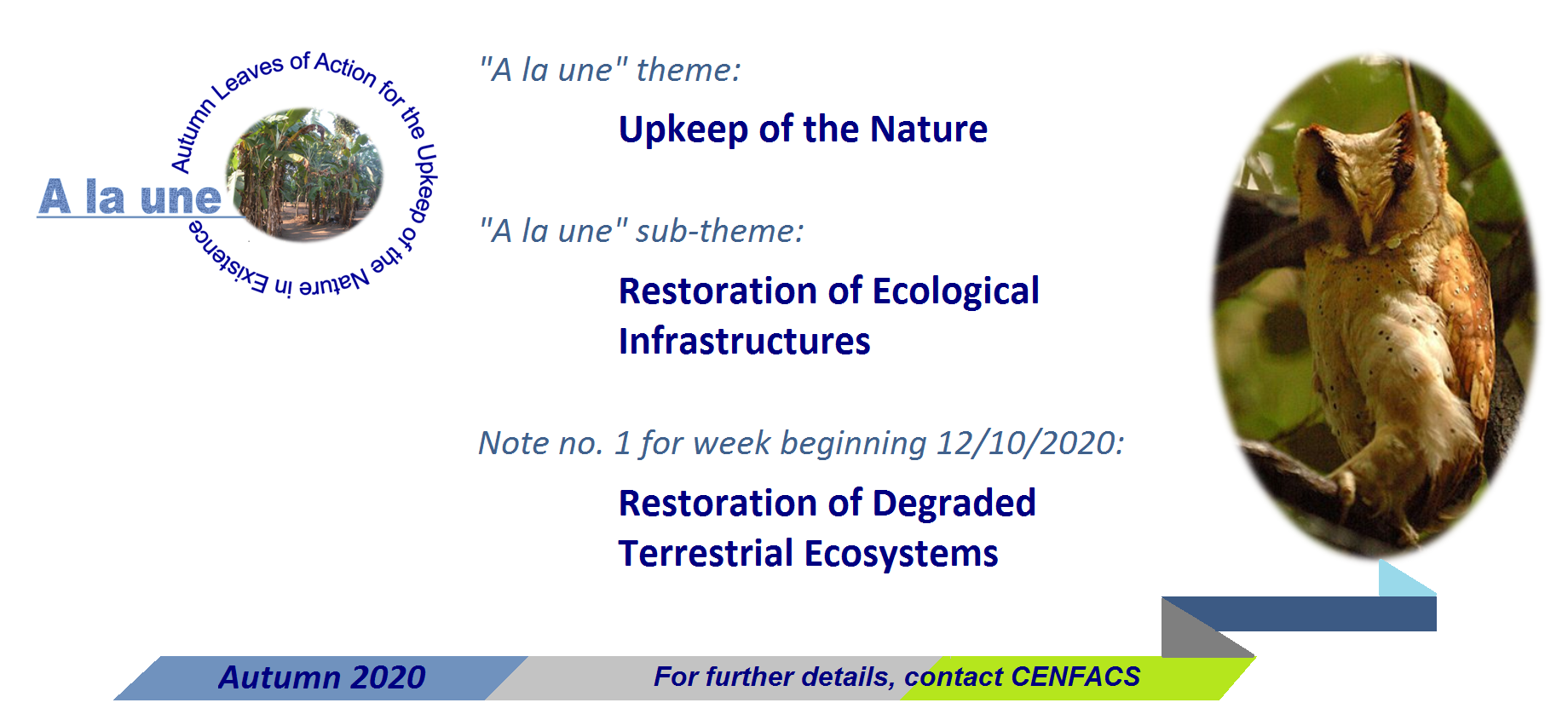Welcome to CENFACS’ Online Diary!
14 October 2020
Post No. 165
The Week‘s Contents
• “A la une” (Autumn Leaves of Action for the Upkeep of the Nature in Existence) Themed Activities
• Giving No Direct Cash Donations
• Climate Protection and Stake in the Post-pandemic Development
… and much more!
Key Messages
• “A la une” (Autumn Leaves of Action for the Upkeep of the Nature in Existence) Themed Activities or Areas of Work
Our environmental campaign “A la une” has already started and is going to last for seven weeks. The main theme of this campaign is still the same, which is Upkeep of the Nature; the sub-theme for this year being Restoration of Ecological Infrastructures. The latter is the action of returning the natural or semi-natural structural ecosystem services to their former conditions.
The selected composed notes or themed areas of work that would work together to shape the central topic or theme of “A la une” Campaign this Autumn have been given under the Main Development section of this post. We have as well provided the periods and titles of these composed notes or themed areas of work.
The first themed area of work is Restoration of Degraded Terrestrial Ecosystems; themed area which kicked off from the 12th of October 2020. Restoration of Degraded Terrestrial Ecosystems is about the action of returning to close to original condition the land-based ecological system relating to forest, desert, grassland or cropland where organisms (such as animals, plants and other organisms) live as habitat in a particular physical environment.
For further information about this first note, please read under the Main Development section of this post.
• 8 No Direct Cash Donations
How to support CENFACS without directly giving cash
Ways of supporting charities have continued to change. We at CENFACS have been implementing these new ways of giving and generating incomes. There are many ways that one can use to support CENFACS without directly given cash. One can unlock barriers to no direct cash donations for CENFACS.
Those who would like to support CENFACS by using other means than directly giving cash, they can consider the following.
Eight ways of donating to consider this Autumn and in the lead up to the end of the year
(1) Giving unwanted goods and items to CENFACS e-charity store at http://cenfacs.org.uk/shop/
(2) Sign up for a Gift Aid declaration from which CENFACS can earn an extra 25p for every £1 you give
(3) Nominate CENFACS for a donation at charity fundraising and donation events
(4) Select CENFACS as your preferred charity for donation from advertising revenue
(5) Raise free funds for CENFACS with your online shopping or choose CENFACS as a donation recipient of some of the profits raised from online shopping
(6) Donate your unwanted and unused points and cashback to CENFACS as your chosen charity from your loyalty shopping rewards or good causes’ gift cards
(7) Name CENFACS as your favourite deserving cause if it happens that you have the opportunity to click the online option “donate cashback to charities”
(8) Donate any unwanted excess points of your loyalty card from apps that may give support to good causes
The above donations are just the few examples of ways of helping that one can think off or come across with to support CENFACS without having to directly give cash. However, this does not mean one cannot donate cash. They can and if you choose to donate cash, CENFACS will happily accept your cash donations.
To support CENFACS without giving directly giving cash and or by directly donating cash, just contact CENFACS.
• Climate Protection and Stake in the Post-pandemic Development
The priority for our Africa-based Sister Organisation (ASOs) during the post-pandemic development is to work together with them so that they can better come out the heavy and dreadful consequences of the Covid-19 outbreak and start to build back better. In this challenging task, one should not forget the climate change issue.
This is why we are carrying on and out the work on climate protection and stake despite the fact that the climate talks that were scheduled in Glasgow for this year have been reported by the end of next year due to the coronavirus pandemic.
We are particularly looking at areas of work with ASOs that need to be adapted to deal with the Covid-19 reality and mitigate its currently standing impact in terms of climate change and other climate issues. The aim here is to protect poor people from adverse impacts of the climate change while advocating with them so that they can have a stake in any climate dividend during the post-pandemic development.
For any enquiries or queries about Climate Protection and Stake in the Post-pandemic Development, please contact CENFACS.
Extra Messages
• Africa’s 33 Least Developed Countries and the Programme of Action for them
Last May, we conducted an Impact Monitoring and Evaluation on CENFACS’ 2011-2020 Follow-up of the Istanbul Programme of Action for the Least Developed Countries (LDCs).
Our follow up work was related to the 33 African countries listed amongst the 47 least developed countries. We noticed that since these 33 African countries were living under the constraint of Covid-19, it was in one’s interest to see how Covid-19 could affect efforts already made in terms of poverty reduction.
• • May 2020 Impact Monitoring and Evaluation
In our impact analysis and the theory of change that we applied, we used the causality-and-attribution approach to explain the key changes that could have happened.
Our findings from the two levels of impact analysis conducted are as follows.
(a) Covid-19 impacted CENFACS’ Follow-up of the 2011-2020 Istanbul Programme of Action
However, one must be careful about this finding since the global health crisis started only by the end of 2019 whereas the Istanbul Programme was set up since 2011. Therefore, many of the results from this programme would not be attributed to the coronavirus pandemic. This is the same for the outcomes of our follow up.
(b) Covid-19 impacted progress made so far in halving child poverty in the 33 African countries
It is probably possible to argue that some of the progress made about halving child poverty could have been affected by the health and economic consequences of the coronavirus pandemic.
For details and contributions to this impact analysis, please contact CENFACS.
• • Findings from the UNECA’s Review
This week and October 2020, we are working on the findings from the 2020 Review of Progress made on the Programme of Action for the Least Developed Countries for the Decade 2011-2020 by the United Nations Economic Commission for Africa.
The United Nations Economic Commission for Africa (1) recognises that there have been noteworthy achievements in indicators (such as child and maternity mortality rates, literacy rates, access to clean drinking water and basic sanitation services) for the LDCs. The UNECA concludes that
“In total, the progress being made against the Programme of Action is not entirely positive”.
In addition to the above findings, Covid-19 may have hampered these efforts made. No-one exactly knows by how much, unless one produces data. This is why we are working on the possible impact of Covid-19 on the users of this programme of action.
For any discussion about or further details about the work on the UNECA’s findings, please contact CENFACS.
• Covid-19 Campaign – Phase 3: Rehabilitation Strategies
Idealistically, the phase of rehabilitation strategies would have happened once the Covid-19 is nearly over. It means that when the epidemiological curve of the Covid-19 symptoms and infections is flattening and gearing towards recovery point and stayed parallel or below the recovery point.
Yet, in the current situation of the virus this is not happening. We are instead witnessing spikes of the coronavirus pandemic to the extent that there are discussions about new waves of lockdown or local lockdowns in some parts of the world including in Africa. This situation poses a dilemma which is: how to rehabilitate economies and lives while keeping tight fight against the coronavirus pandemic?
The answer to this question/dilemma could vary. There are many options available.
One could learn from the mistakes and experiences from the methods and tools applied so far. Then, one can try to redevelop or develop a clear rehabilitation strategy with new or improved tools to continue the fight against the coronavirus pandemic.
One can also have a clever or prudent combination of both smart health restrictions/rules and the implementation of rehabilitation works.
Furthermore, there could be a need to continue applying the shadowing model of following the epidemiological curves (“epi-curves”) of the coronavirus pandemic while undertaking the rehabilitation work as planned in a given rehabilitation strategy. This way of proceeding could be about building back better while matching the efforts of building back better to that of rehabilitating the economy and lives in need by using the shadowing framework or model.
The above suggestions or options are neither a definite process nor an end itself as they are only some of the possible ways of approaching or looking at rehabilitation phase of our Campaign of Resilience against the Coronavirus Pandemic.
For more on Covid-19 Campaign by CENFACS and in-depth discussion about our rehabilitation strategy, please do not hesitate to contact CENFACS.
• Revisiting the Appeal about the African Sahel and Lake Chad Basin
Last September, we carried out a review of the situation in the African Sahel and Lake Chad Basin. As a result of this review, we launched an appeal to reduce extreme poverty in the African Sahel and Lake Chad Basin.
Last week, we discussed the situation of people crossing the line of extreme poverty for the first time. We tried to find out from the consumption poor what it looks and feels like crossing the line of extreme poverty for the first time.
Following on this discussion, we are revisiting the African Sahel and Lake Chad Basin Appeal in order to search on how people are dealing with extreme poverty and what has been done so far to work with them to come out this extreme poverty. We are as well assessing how our appeal went down in terms of effectiveness about working with the peoples of these two areas to reduce extreme poverty.
We are therefore revisiting and discussing the above mentioned appeal in the light of the current difficult moments that ordinary and civilian people in these two areas are undergoing in terms of extreme poverty.
To enquiry about this appeal revisiting and discussion, please contact CENFACS.
Main Development
• “A la une” (Autumn Leaves of Action for the Upkeep of the Nature in Existence) Themed Activities or Areas of Work
• • Seven Weeks of Campaign for the Upkeep of the Nature
As announced earlier, we have started our 7-week campaign work for the Upkeep of the Nature. It is our well-known household campaign for nature in the autumnal season; a campaign which is happening against the background of the continuing economic and health threats from the coronavirus pandemic.
Keeping this nature campaign alive at this difficult time could mean that one is trying to make an effort to maintain healthy relationships between humans and nature so that future health crisis can be prevented and/or further damage to our health systems and economies could be limited. It could also signify that one is trying to keep their hands on the fight against the adverse impacts of climate change while still dealing with the mounting health and economic challenges brought by the coronavirus pandemic.
Since we are acting in the context of Autumn of Acceptance and Integration in order to Build Back Better our lives and economies, the sub-theme of “A la une” will be about Restoration of Damaged or Degraded Ecological Infrastructures while the “A la une” theme remains the same which is: Upkeep of the Nature; as outlined earlier.
Within these theme and sub-theme, we have composed seven notes excluding monitoring and evaluation of the “A la une” Campaign. These notes can be found below.
• • “A la une” Composed Notes or Themed Areas of Work
During the following periods within this Autumn and “A la une” season, CENFACS’ advocacy on environment will focus on the following areas from the beginning of every Mondays (starting from 12 October 2020 to the rest of November 2020).
Periods Titles of notes or themed areas of work
12/10 to 18/10/2020 Terrestrial ecosystems
19/10 to 25/10/2020 Inland water
26/10 to 01/11/2020 Marine/aquatic ecosystems
02/11 to 08/11/2020 Nature species
09/11 to 15/11/2020 Ecological investment
16/11 to 22/11/2020 African organisations’ restoration work
23/11 to 29/11/2020 Finance for ecology
30/11/2020 “A la une” monitoring and evaluation
In total, there are seven themed areas of work starting from the 12th of October 2020 and thereafter every Mondays until the end of November. These activities will help us to re-communicate our environmental message for the upkeep of the nature in existence as well as triggering better changes with our leaves of action. At the end of these notes, we shall carry out monitoring and evaluation.
To engage with “A la une” themed areas, please contact CENFACS.
• • In Focus for Week Beginning 12/10/2020: Restoration of Degraded Terrestrial Ecosystems
Before tackling the note about terrestrial ecosystems, let us explain some key concepts for this year’s sub-theme. In particular, we are going to explain the following concepts so that readers and supporters know what we are talking about: ecological restoration and infrastructures.
• • • Understanding ecological restoration
According to Nature Education (2), ecological restoration
“aims to recreate, initiate, or accelerate the recovery of an ecosystem that has been disturbed. Disturbances are environmental changes that alter ecosystem structure and function. Common disturbances include logging, damming rivers, intense grazing, hurricanes, floods, and fires. Restoration activities may be designed to replicate a pre-disturbance ecosystem or to create a new ecosystem where it had not previously occurred.”
This definition will be used for our “A la une” Campaign. This does not mean that it is the only one within the literature review. We have just selected it for our work as we notice that it is a bit comprehensive.
• • • Interpreting ecological infrastructure
Ecological infrastructure can be explained in many ways. In the context of our campaign, we have selected the definition given by the Intergovernmental Science-Policy Platform on Biodiversity and Ecosystem Services (Ipbes) (3) which says that
“Ecological infrastructure refers to the natural or semi-natural structural elements of ecosystems and landscapes that are important in delivering ecosystem services. It is similar to ‘green infrastructure’, a term sometimes applied in a more urban context. The ecological infrastructure needed to support pollinators and improve pollination services includes patches of semi-natural habitats, including hedgerows, grassland and forest, distributed throughout productive agricultural landscapes, providing nesting and floral resources. Larger areas of natural habitat are also ecological infrastructure, although these do not directly support agricultural pollination in areas more than a few kilo-meters away from pollinator-dependent crops.”
The Ipbes definition will be one of the working terms we shall use in this campaign since it covers many aspects related to the ecological infrastructure.
Both ecological restoration and infrastructure are important in the restoration of degraded terrestrial ecosystems as the following elements of this first note shows.
• Restoration of Degraded Terrestrial Ecosystems
This is what the FAO and UNEP (4) said in their joint publication:
“We must build on this momentum to catalyse bold actions to prevent, halt and reverse the loss of forests and their biodiversity, for the benefit of current and future generations”.
From this saying, one can try to explain the degradation of terrestrial ecosystems.
• • Explaining the degradation of terrestrial ecosystems
One of the reasons that restoration of terrestrial ecosystems or land happens is because of degradation. The website www.frontiersin.org (5) defines land degradation as
“the loss of functions and services provided by ecosystems”.
This website further explains that
“these include climate regulation, the provision and retention of water, conservation of biodiversity, the cycling of essential nutrients, and food security”.
From the above explanation, one can argue that Restoration of Degraded Terrestrial Ecosystems is the action of returning to close to its original condition the land-based ecological system relating to forest, desert, grassland or cropland where organisms (such as animals, plants and other organisms) live as habitat in a particular physical environment.
From the above perspectives, our “A la une” Campaign is about voicing for the return of land-based ecological system close to its original condition. It is about working together with local people to re-establish the structure and function of a damaged habitat or ecosystem.
• • Restoration of degraded land as a global goal
Restoration of degraded land is part of the United Nations Sustainable Development Goal 15 of Life on land (6), which is about sustainably manage forests, combat desertification, halt and reserve land degradation, halt biodiversity loss.
Target 3 of this Goal 15 states that
“By 2030, combat desertification, restore degraded land and soil, including land affected by desertification, drought and floods, and strive to achieve a land degradation-neutral world”.
For example, according to the FAO (Food and Agriculture Organisation of the United Nations) and the UNEP (United Nations Environment Programme) (4),
“Africa had the highest net loss of forest area in 2010–2020, with a loss of 3.94 million hectares per year … Since 1990 Africa has reported an increase in the rate of net loss” (p. 11).
Additionally, the effects of the coronavirus pandemic may not be neutral to the conditions of land in Africa. There could be a need to reassess the state of the land in Africa in terms of the Covid-19 effects.
• • The focus in the restoration of degraded terrestrial ecosystems
Our Restoration campaign focuses on the plan, cost and benefits of restoration projects dealing with aspects of ecological infrastructures related to terrestrial ecosystems. In other words, any restoration of terrestrial ecosystems will need a plan and will incur cost and will involve finance. The advantages or disadvantages of restoration will need to be properly assessed so that the campaign can reach its main aim of the upkeep of the nature in existence.
Finally, to materialise the context of Autumn of Acceptance and Integration, one may need to integrate the coronavirus effect in their restoration projects or any project of building back better terrestrial ecosystems.
Briefly, this is our first note of the “A la une” Campaign for this year.
To find out more about this first note and/or the entire “A la une” campaign, please contact CENFACS.
____
(1) https://www.uneca.org/publications/2020-review-progress-made-programme-action-least-developed-countries-decade-2011%E2%80%932020 (accessed 10/10/2020)
(2) https://www.nature.com/scitable/knowledge/library/restoration-ecology-13339059/ (accessed on 10/10/2020)
(3) https://ipbes.net/glossary/ecological-infrastructure (accessed on 10/10/2020)
(4) FAO and UNEP, 2020: The State of the World’s Forests 2020 – Forests, biodiversity and people, Rome. https://doi.org/10.4060/ca8642en
(5) https://www.frontiersin.org/research-topics/14001/restoration-of-degraded-terrestrial-ecosystems (accessed on 10/10/2020)
(6) http://www.undp.org/content/undp/en/home/presscenter/pressreleases/2015/09/24/undp-welcomes-adoption-of-sustainable-development-goals-by-world-leaders.html
____
Help CENFACS keep the Poverty Relief work going in 2020.
We do our work on a very small budget and on a voluntary basis. Making a donation will show us you value our work and support CENFACS’ work, which is currently offered as a free service.
One could consider a recurring donation to CENFACS in the future.
Donate to support CENFACS!
FOR ONLY £1, YOU CAN SUPPORT CENFACS AND CENFACS’ PROJECTS, JUST GO TO http://cenfacs.org.uk/supporting-us/
Thank you for visiting CENFACS website and reading this post.
Thank you as well to those who made or make comments about our weekly posts.
We look forward to receiving your regular visits and continuing support throughout 2020 and beyond.
With many thanks.

